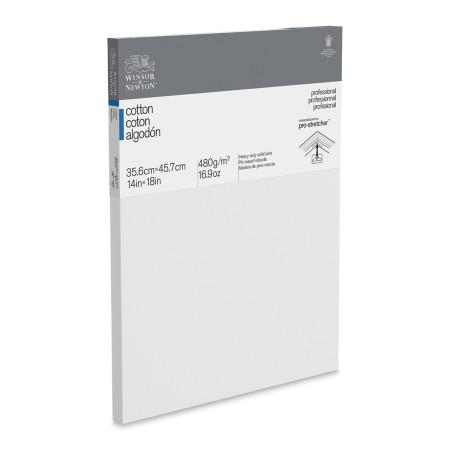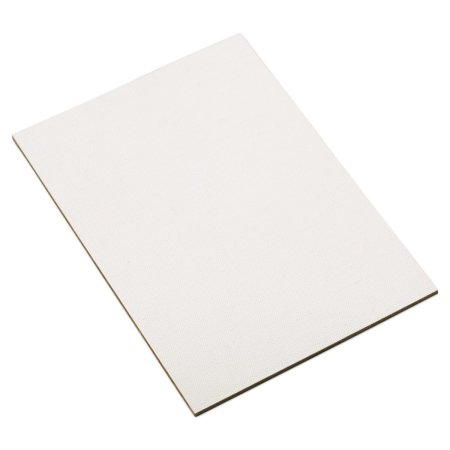There are two main types of canvas available to painters, cotton and linen. Each is made from different fabric—cotton is made from the cotton plant and linen is made from flax. Aside from what they are made out of, there are some notable differences between the properties of the two types of canvas.
In this guide, learn the differences between the two fabrics and discover which would better suit your painting practice.
Disclaimer: Fine Art Tutorials is a reader supported site. When you make purchases through links on this site, we may earn a small commission at no extra cost to you.
Cotton vs linen canvas: product picks
Winsor & Newton Cotton Canvas

This professional grade cotton canvas has been hand stretched for optimum tension with kiln dried wooden stretcher bars. The texture provides a great absorbency and tooth. Cotton is an affordable option for artists.
Linen canvas

Linen is strong, durable and favoured by professional artists.
Cotton vs linen canvas: Which is more durable?
Linen is the canvas of choice for artists who want their paintings to stand the test of time. Cotton is more flexible, while linen is more rigid. This means that linen is much less likely to warp or dent.
It’s possible for stretched cotton canvases to become loose and dent over time. Fixing dents is relatively simple. Spray a tiny amount of water on the back of the dent, and leave it to soak. To fix sagging corners of the canvas, reinforce with the wooden bars that come in the pack.
If you are painting on a large scale, then linen should be your surface of choice, as it’s less likely to dip or warp in the centre after a painting session. For rigorous painting techniques, I would recommend linen as being the tougher choice.
What is the longevity of the two materials?
Linen will stand the test of time, whereas cotton won’t to the same extent. It’s an investment if you want to sell your artworks, or pass them down through the generations.
The threads that make the linen fabric don’t expand or contract as a result of the moisture content as much as cotton. They are more stable in a variety of environments, be it humid or dry. Linen fabric also contains oils in its fibres, meaning that it stops the canvas from becoming brittle with age. So if you’re looking to sell your artwork, advertise it as ‘fine art’, price it higher or send it to a gallery, I would recommend painting on linen.
Cotton vs linen canvas: which is more suitable for oil painting?
Linen is more suitable for oil painting than cotton, as it is more rigid and less likely to warp. When oil dries, the paint film becomes inflexible. If a cotton canvas, warps too much the rigid oil paint film could crack.
If kept at a stable temperature and in an environment that doesn’t have extreme fluctuations in humidity, cotton won’t warp. So it’s not a common feat for a cotton canvas to lose its shape, but it is more likely to happen with cotton than linen. It’s the durability of linen that makes it more attractive to professional artists.
Acrylic paint dries to a flexible film, so if you don’t have to worry as much about the potential of the paint film cracking when using cotton canvas. For a comprehensive product review of the best canvases for painting, check out our guide.
Cotton vs linen canvas: is the texture different?
Cotton has a more consistent but prominent texture. This is less suited to fine detail work as small brushes and fine lines can get lost in the weave.
Linen has a unique texture. It’s finer and more suited to painting in details, but also has a more natural look to it. The surface texture of linen makes it perfect for oil and acrylic paint, as both mediums need a slight surface texture to adhere to the surface.
You can buy both linen and cotton canvases in a range of textures from smooth to rough from Winsor & Newton, that have been smoothed and primed by the manufacturer.
Cotton vs linen: how do you prepare the canvas for painting?
In order to paint on canvas, be it cotton or linen, the fabric first needs to be stretched around wooden bars, then primed ready for paint.
There are many ready made options available to artists who want a surface that they can take out of the box and paint straight onto. Manufacturers such as Winsor & Newton and Belle Arti will prime canvases with gesso so it is ready to paint onto.
The preparation process for raw canvas is the same, despite whether you are working with linen or cotton.
If you buy a ready made canvas, make sure you read the product description. It will tell you if gesso has been applied already or not. A canvas that is labelled as ‘universally primed’ will have been prepared with acrylic sealant and gesso. Choose to paint with acrylic or oil on universally primed canvases. On ‘oil primed’ canvases, however, stick to painting with oils.
For a smoother surface, which is better for painting in fine detail, sand your primed canvas with fine tooth sandpaper, then apply a few extra coats of gesso.
Cotton vs linen: which is more expensive?
Professional painters often opt to buy linen canvas as it is more sturdy and hard wearing, however it can be more expensive. Fewer brands supply linen canvases. You can opt to buy fabric yourself, then stretch and prime it. Painters who do this like the control they have over the outcome of their painting substrate.
Cotton is more readily available and easier to make. It’s easy to find various brands that stock super cheap cotton canvases. Artist grade cotton is more tightly woven and therefore stronger, but this will come at a slightly higher price point.
Look at your budget and the options available. If you’re wanting to get an inexpensive surface to practice on, go for cotton. It is still a high quality surface to use with a range of mediums. Get used to how it feels to paint on canvas by practising on cotton before you invest in linen.
If you plan to work large, sell your paintings, or if you prefer something more rigid and high quality, linen is a worthwhile investment to make.
Cotton vs linen canvas: Pin it!
If you’ve found anything on this site especially useful, you can make a donation to me through PayPal. I take a lot of time to research and write each topic, making sure each tutorial is as detailed as possible and I make all my content freely available. Any small donation (even the price of a cup of coffee!) can help me to cover the running costs of the site. Any help from my readers is much appreciated :).
Follow the link in the button below to support this site.


I grew in Paris, France and studied painting there at the Beaux-Arts School. Everybody I new were using linen then. I moved to Chicago in 1979 and everybody I new were painting on cotton. Some years ago somebody gave me two enormous 96″ rolls of cotton canvas that are mounted on a wall in my studio. I can’t afford not using them.